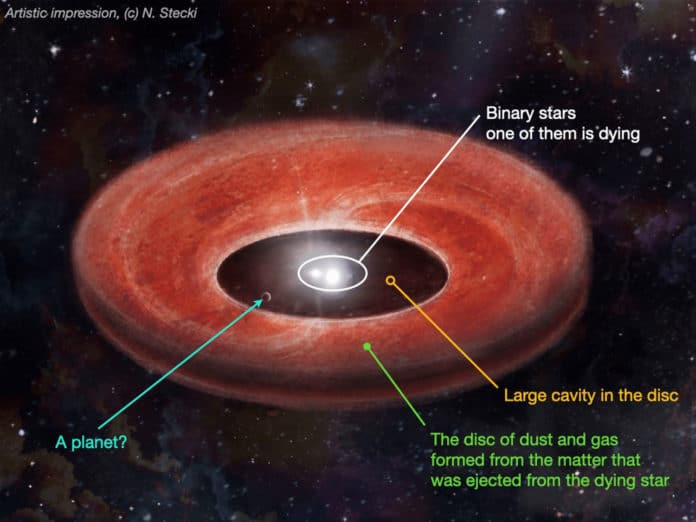Planets revolve around the stars. These stars are much older than the planets. KU Leuven astronomers recently discovered a new scenario, suggesting that even dying stars could form planets.
The star at the center of the Solar System– the Sun- started burning 4.6 billion years ago. In the next million years, the matter around it clumped into protoplanets. The birth of the planets in that protoplanetary disc explains why the planets orbit in the same plane.
Such protoplanetary discs are believed to exist around newborn stars. But, it is not necessary. They can also develop independently from star formation, for example, around binary stars of which one is dying.
A dying star catapults the outer part of its atmosphere into space end up as a white dwarf. When it comes to binary stars, the gravitational pull of the second star causes the matter ejected by the dying star to form a flat, rotating disc. This disc resembles the protoplanetary discs that astronomers observe around young stars elsewhere in the Milky Way.
Well, this is well known. What’s new is that the discs surrounding so-called evolved binary stars do not uncommonly show signs of planet formation, as discovered by astronomers. Furthermore, their observations show that this is a rare case: it occurs in one in ten of these binary stars.
KU Leuven astronomer Jacques Kluska, the first author of the article, said, “In ten percent of the evolved binary stars with discs we studied, we see a large cavity (avoid/opening, ed.) in the disc. This is an indication that something is floating around there that has collected all matter in the area of the cavity.”
“The clean-up of the matter could be the work of a planet. That planet might not have formed at the very beginning of one of the binary stars’ life but at the very end.”
“We also found further strong indications for the presence of such planets. In the evolved binary stars with a large cavity in the disc, we saw that heavy elements such as iron were very scarce on the surface of the dying star.”
“This observation leads one to suspect that dust particles rich in these elements were trapped by a planet.”
Astronomers made this discovery while preparing an inventory of evolved binary stars in the Milky Way. They did that based on existing, publicly available observations.
Kluska and his colleagues counted 85 of such binary star pairs. In ten pairs, the researchers came across a disc with a large cavity on the infrared images.
Further analysis is required to confirm the existence of planets around evolved binary stars. If it turns out the planets were only formed after one of the stars had reached the end of its life, the theories on planet formation will need to be adjusted.
Professor Hans Van Winckel, head of the KU Leuven Institute of Astronomy, said, “The confirmation or refutation of this extraordinary way of planet formation will be an unprecedented test for the current theories.”
Journal Reference:
- J. Kluska et al. A population of transition disks around evolved stars: Fingerprints of planets. DOI: 10.1051/0004-6361/202141690
